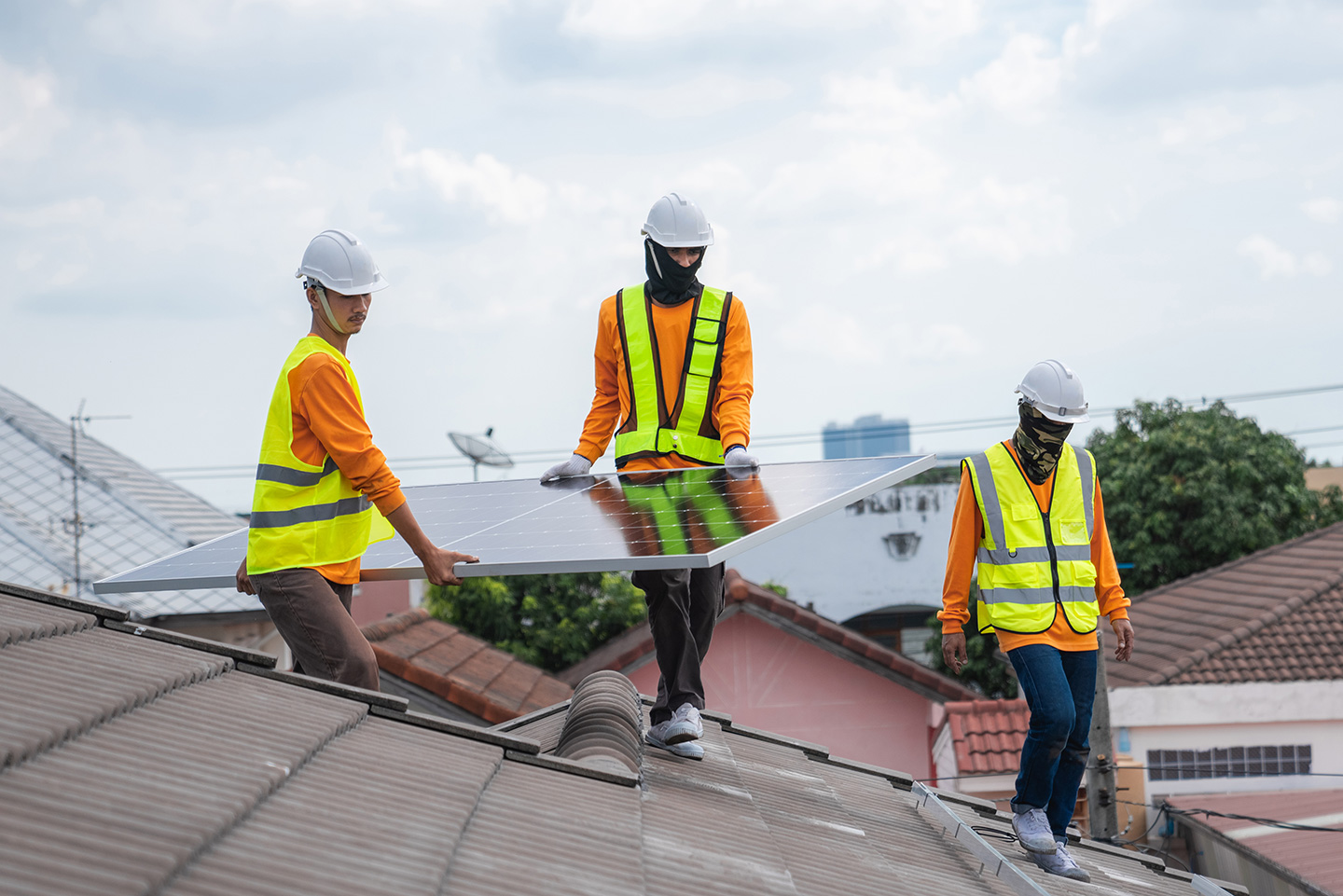The roofing industry is undergoing an unprecedented transformation as it enters 2026. From AI-powered field management to sustainable materials that meet evolving climate challenges, roofing contractors face both opportunities and operational complexities that require strategic adaptation.
Whether you’re managing growing project volumes, navigating labor shortages, or meeting increasing demands for energy-efficient solutions, understanding these trends will determine your competitive position in a rapidly evolving market.
Here are the key roofing industry trends for 2026:
- Market expansion driven by aging infrastructure and climate demands
- Technology integration is revolutionizing operations and customer experience
- Sustainability requirements becoming standard, not optional
- Labor solutions based on increased automation and enhanced training programs
- Advanced materials offering superior performance and longevity
Roofing Industry Trends for 2026
Roofing Market Growth Accelerates Despite Challenges
The global roofing market is projected to reach USD 130 billion by 2033, growing at a CAGR of 3.3% from 2026¹. This growth reflects several converging factors: aging housing stock built during the 2000s boom reaching replacement cycles, increased storm frequency requiring repairs, and new construction demands.
Roofing Industry Market Trends for 2026
| Market Segment | 2026 Value | Growth Rate | Key Drivers |
|---|---|---|---|
| Global Roofing Market | $132.5 billion | 3.3% CAGR | Aging |
| Commercial Roofing Materials | $14.2 billion | 6.1% CAGR | Energy efficiency demands |
| Solar Roofing Systems | $8.9 billion | 15% CAGR | Sustainability mandates |
| US Roofing Market | $31.38 billion | 6.17% CAGR | Construction activity, replacements |
The US market is expected to show stronger growth at a 6.17% CAGR, reaching $42.33 billion by 2030². This acceleration stems from regulatory changes, energy efficiency requirements, and an increase in insurance claims from extreme weather events.
AI and Automation Transform Field Operations
Technology adoption in roofing has moved from optional to essential. Contractors now use drones for over 55% of projects, primarily for inspections and measurements³. This shift addresses both safety concerns and labor efficiency needs.
AI-powered roofing management platforms are streamlining operations that previously required multiple site visits and extensive paperwork. These systems handle everything from aerial damage assessment to automated insurance reporting, significantly reducing project timelines.
Digital transformation benefits include:
- 30-40% reduction in inspection time through drone technology
- Automated scheduling and dispatch optimization
- Real-time project tracking and customer communication
- Integration with insurance platforms for faster claim processing
Advanced platforms like Zuper for Roofing exemplify this trend, offering AI-powered solutions that manage the entire roofing workflow from lead generation to final payment collection⁴.
Sustainability Becomes Standard Operating Procedure
Environmental considerations are no longer niche requirements; they are now essential. Solar roofing systems are experiencing 15% annual growth, driven by both regulatory mandates and economic incentives¹. California’s Title 24 requirements and similar regulations in other states are making energy-efficient roofing materials standard specifications.
Key sustainable roofing solutions that are gaining adoption include:
- Cool roofs: Reflective materials reducing energy consumption by 30-43% in Mediterranean climates⁵
- Green roofing systems: Absorbing up to 65% of rainwater while providing insulation benefits
- Solar-integrated materials: Including both traditional panels and innovative solar shingles
- Recycled and synthetic materials: Offering durability without environmental impact
These solutions appeal to both commercial clients seeking LEED (Leadership in Energy and Environmental Design) certification and residential customers focused on long-term energy savings.
Advanced Materials Address Performance Demands
Material innovation is responding to increasingly severe weather patterns and the growing demand for durability. Class 4 impact-resistant shingles are becoming standard in hail-prone regions, while fire-resistant materials are essential in wildfire areas.
Metal roofing continues gaining market share due to its 40-70 year lifespan and energy efficiency benefits. Synthetic materials now replicate the appearance of premium materials, like slate and wood shake, while offering superior weather resistance and reduced maintenance requirements.
Material performance improvements include:
- Enhanced wind resistance ratings for severe weather zones
- Self-healing capabilities in certain membrane applications
- Improved thermal performance, reducing HVAC loads
- Modular systems enabling faster installation
Labor Shortages Drive Innovation Solutions
The construction industry is projected to need 439,000 new workers in 2025, increasing to nearly 500,000 by 2026⁶. Roofing contractors are addressing this challenge through multiple strategies:
Technology-enabled solutions:
- Robotic installation systems for repetitive tasks
- Prefabricated modular components reduce on-site labor
- Enhanced training programs using VR and digital simulations
- Automated material handling and positioning systems
Workforce development initiatives:
- Apprenticeship programs with community colleges
- Safety certification programs are attracting quality workers
- Competitive compensation packages reflecting skill demands
- Cross-training programs are increasing in versatility
Employment for roofers is projected to grow 6% from 2023 to 2033, faster than average for all occupations, with median wages reaching $50,030 annually⁷.
Commercial Roofing Drives Premium Growth
Commercial roofing materials represent a $14.2 billion market by 2026, growing at 6.1% annually². Businesses are prioritizing solutions offering long-term durability and energy efficiency, creating opportunities for contractors specializing in commercial applications.
Commercial trends include:
- Green roof installations for urban heat island reduction
- Energy-efficient flat roofing systems with 41% sales increases
- Integration with building automation systems
- Preventive maintenance contracts are generating recurring revenue
Data-Driven Operations Become a Competitive Advantage
Successful roofing contractors are leveraging data analytics for more accurate bidding, better resource allocation, and improved customer service. Platforms providing real-time analytics help businesses understand profitability patterns, optimize scheduling, and reduce callbacks.
Data applications include:
- Historical trend analysis for accurate project estimation
- Weather integration for scheduling optimization
- Customer behavior patterns for improved follow-up strategies
- Material cost forecasting for competitive bidding
Strategic Positioning for 2026 Success
The roofing industry’s evolution of current trends requires contractors to adapt business models, not just techniques. Those investing in technology integration, sustainable solution offerings, and workforce development are positioned for growth in an expanding market.
Key success factors include embracing field service management platforms that integrate all business operations, developing expertise in energy-efficient materials, and building partnerships with suppliers offering innovative solutions.
As the industry moves toward a global market value of $130 billion, contractors who combine technological efficiency with sustainable expertise will capture the highest-value projects and build lasting competitive advantages.
Ready to take advantage of the top roofing industry trends of 2026? Explore Zuper for Roofing’s all-in-one, AI-powered solution with a 1:1 demo.
Sources:
- Cognitive Market Research – Roofing Market Report 2025
- Mordor Intelligence – United States Roofing Market Analysis
- Conexpo-Con/Agg – Contractor Drone Usage Statistics 2024
- Business Wire – Zuper for Roofing Launch Announcement
- Urbanscape Architecture – Green Roof Energy Efficiency Studies
- Hiring Lab – 2025 US Jobs and Hiring Trends Report
- US Bureau of Labor Statistics – Roofer Employment Projections



